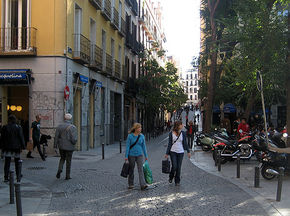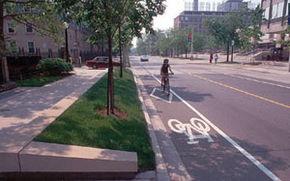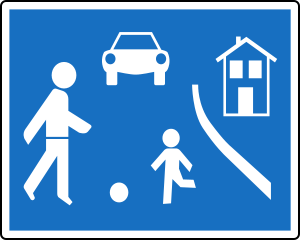
 Cars Are Slowing Down in European Cities, reasonstobecheerful.world (Jun 11, 2024)
Cars Are Slowing Down in European Cities, reasonstobecheerful.world (Jun 11, 2024)
- WHO adds its voice to evidence that 20mph limits are required for authorities to meet "duty of care" responsibilities, May 8, 2017...[1]
Road traffic safety refers to the methods and measures used to prevent road users from being killed or seriously injured. Typical road users include pedestrians, cyclists, motorists, vehicle passengers, and passengers of on-road public transport (mainly buses and trams).
Best practices in modern road safety strategy:
The basic strategy of a Safe System approach is to ensure that in the event of a crash, the impact energies remain below the threshold likely to produce either death or serious injury. This threshold will vary from crash scenario to crash scenario, depending upon the level of protection offered to the road users involved. For example, the chances of survival for an unprotected pedestrian hit by a vehicle diminish rapidly at speeds greater than 30 km/h, whereas for a properly restrained motor vehicle occupant the critical impact speed is 50 km/h (for side impact crashes) and 70 km/h (for head-on crashes).
As sustainable solutions for classes of road safety have not been identified, particularly low-traffic rural and remote roads, a hierarchy of control should be applied, similar to classifications used to improve occupational safety and health. At the highest level is sustainable prevention of serious injury and death crashes, with sustainable requiring all key result areas to be considered. At the second level is real-time risk reduction, which involves providing users at severe risk with a specific warning to enable them to take mitigating action. The third level is about reducing the crash risk which involves applying the road-design standards and guidelines (such as from AASHTO), improving driver behavior and enforcement. It is important to note that drivers' traffic behaviors are significantly influenced by their perceptions and attitudes.
Traffic safety has been studied as a science for more than 75 years.
Events[edit | edit source]
 May 15 - 21, 2023 (Mon - Sun) — UN Global Road Safety Week
May 15 - 21, 2023 (Mon - Sun) — UN Global Road Safety Week Nov 19, 2023 (Sun) — World Day of Remembrance for Road Traffic Victims, third Sunday in November each year, worlddayofremembrance.org
Nov 19, 2023 (Sun) — World Day of Remembrance for Road Traffic Victims, third Sunday in November each year, worlddayofremembrance.org
- 2021-2030, Decade of Action for Road Safety 2021-2030
Community action projects[edit | edit source]
- Road safety surveys
- advocate slower speed initiatives and / or traffic calming
- advocate town squares or car-free zones
- advocate Living streets
- investigate Shared space design solutions
- advocate Home zones and Quiet Lanes, see Road safety UK
Car-free zones[edit | edit source]
Pedestrian zones (also known as auto-free zones and car-free zones, and as pedestrian precincts in British English) are areas of a city or town reserved for pedestrian-only use and in which some or all automobile traffic may be prohibited. They are instituted by communities who feel that it is desirable to have pedestrian-only areas. Converting a street or an area to pedestrian-only use is called pedestrianisation.
Pedestrian zones have a great variety of attitudes or rules towards human-powered vehicles such as bicycles, inline skates, skateboards and kick scooters. Some have a total ban on anything with wheels, others ban certain categories, others segregate the human-powered wheels from foot traffic, and others still have no rules at all. Many of Middle Eastern casbas have no wheeled traffic, but use donkey-driven or hand-driven carts for freight transport. W

Living streets[edit | edit source]
Streets designed primarily with the interests of pedestrians and cyclists in mind and as a social space where people can meet and where children may also be able to play legally and safely. These roads are still available for use by motor vehicles, however their design aims to reduce both the speed and dominance of motorised transport. This is often achieved using the shared space approach, with greatly reduced demarcations between vehicle traffic and pedestrians. Vehicle parking may also be restricted to designated bays. It became popular during the 1970´s in the Netherlands, which is why the Dutch word for a livingstreet (woonerf) is often used as a synonym.
Country-specific living street implementations include: complete streets (United States and Canada), home zone (United Kingdom), residential zone (ru:Жилая зона, Russia) shared zone (Australia / New Zealand), woonerf (Netherlands and Flanders) and zone résidentielle (France). W
[edit | edit source]
An urban design approach which seeks to minimise demarcations between vehicle traffic and pedestrians, often by removing features such as curbs, road surface markings, traffic signs, and regulations. Typically used on narrower streets within the urban core and as part of living streets within residential areas, the approach has also been applied to busier roads, including Exhibition Road in Kensington, London. W

Complete Streets[edit | edit source]
A transportation policy and design approach (United States and Canada), that requires streets to be planned, designed, operated, and maintained to enable safe, convenient and comfortable travel and access for users of all ages and abilities regardless of their mode of transportation. Complete Streets allow for safe travel by those walking, bicycling, driving automobiles, riding public transportation, or delivering goods. W

Vision Zero[edit | edit source]
Road traffic safety project started in Sweden in 1997 which aims to achieve a highway system with no fatalities or serious injuries in road traffic. A core principle of the vision is that 'Life and health can never be exchanged for other benefits within the society' rather than the more conventional approach where a monetary value is placed on life and health which is then used with a Benefit-cost ratio evaluation before investing money in the road network to decrease risk.
Vision Zero is based on four principles:
- Ethics: Human life and health are paramount and take priority over mobility and other objectives of the road traffic system:*Responsibility: providers and regulators of the road traffic system share responsibility with users;
- Safety: road traffic systems should take account of human fallibility and minimize both the opportunities for errors and the harm done when they occur; and
- Mechanisms for change: providers and regulators must do their utmost to guarantee the safety of all citizens; they must cooperate with road users; and all three must be ready to change to achieve safety.
Vision Zero style initiatives have been implemented in Sweden and several other countries including the Netherlands, United Kingdom, United States, France, Germany, Spain, and Norway. W
Resources[edit | edit source]
Citizens data initiative[edit | edit source]
According to the Global status report on road safety, road traffic crashes take the lives of nearly 1.3 million people every year, and injure 20–50 million more.[2] More than 90% of road traffic deaths and injuries occur in low-income and middle-income countries, which have only 48% of the world's registered vehicles.
Other resources[edit | edit source]
The Global Alliance of NGOs for Road Safety is a collection of nongovernmental organizations (NGOs) that implement programs and lobby for road safety initiatives around the world. As an umbrella organization, it currently represents more than 200 member NGOs from 90-plus countries.
The wikipedia article lists member NGOs by country.
Why it matters[edit | edit source]
Some quick points:
Major cause of deaths and injuries (directly)[edit | edit source]
As an example traffic "accidents" kill more than 40,000 each year in the United States alone.
In the western world the number of deaths have been declining in recent years, but in the developing world / "the south", traffic accidents take a larger and a growing toll, as the affluent increasingly use cars, but little is done to ensure acess and safety for those travelling by more sustainable means.
Major cost to society[edit | edit source]
- Insurance
- Construction to improve safety
- Safety features in cars
- Health sector: Emergency services, rehabilitation, psychological and economic burden of victims families
Major cause of deaths and bad health (indirectly)[edit | edit source]
It has been claimed that a large part of the 400,000 estimated to die from a sedentary lifestyle and bad diet in the U.S. yearly could have lived longer if they had used their legs and hearts to go to work/school etc instead of using private cars. The World health organisation recommends 30 minutes of moderate exercise daily.
The fear of being killed in traffic accidents, and partly the measures being put in place to keep pedestrians and cyclists "safe" - that is keep them off the roads, deters people from walking or biking, but using private cars instead. (It needs to be mentioned that in well-functioning cities public transport and walking/cycling can be combined).
Safety concerns discourage sustainable transport[edit | edit source]
When sustainable transport is discouraged, population health is harmed through inactivity, but a modal shift to cycling, walking and the use of public transport would also reduce NOx, SOx, dust, noise, CO2, N2O, ground-level ozone and smog.
What improves safety? - Any tradeoffs ?[edit | edit source]
The measured improvement in traffic safety in the rich countries, is in part explained by better emergency treatment. Victims that would not have surivived 20 years ago now do. But this costs society a great deal, and seriously injured and molested people are many times as many as the ones killed, and very many of them require special and expensive care for the rest of their lives.
Part of the improvement can be linked to safer cars (safer for the occupants), and safer roads (primarily for motorists).
Part of the improvement might be explained by fewer sustainable and "soft" actors being out there in the traffic. The costs of this shift in terms of obesity/a sedentary lifestyle appears to offset what has been gained from technological advances.
Part of the improvement stems from the realisation that speed kills, and the subsequent creation of reduced speed-zones.
Past events[edit | edit source]

2011-2020 Time for Action - Decade of Action for Road Safety
Officially proclaimed by the United Nations General Assembly in March 2010. Its goal is to stabilize and reduce the forecast level of road traffic deaths around the world. It is estimated that 5 millions lives could be saved on the world's roads during the Decade. W
Campaigns[edit | edit source]
Make Roads Safe, global road safety campaign, W includes a Criticism section
See also[edit | edit source]
- Road safety UK
- Community safety
- Cycling, sustainable community action
- Environment quality
- Sustainable transport activism
- Urban sustainability
local information can be found, or shared, via our many location pages
External links
- Wikipedia: Road traffic safety, Traffic calming, 30 km/h zone
- United Nations Road Safety Collaboration
References
- ↑ @20splentyforus
- ↑ WHO, Global status report on road safety, 2009.